SENGBE PIEH Sengbe Pieh was a Mende farmer
whose extraordinary courage in resisting slavery earned him a lasting
place in the histories of Sengbe was captured in his rice farm in January, 1839 and ultimately sold to a Spanish slave trader near modern Sulima. He was then transported across the Atlantic to Havana, Cuba and sold at an auction, along with forty-eight other Sierra Leoneans, to a Spanish sugar planter named Jose Ruiz. The Spaniard placed his slaves aboard a ship called the Amistad for a short trip to his plantation, but on the third day at sea, Sengbe pulled a loose spike from the deck and broke his chains and those of his fellow slaves. He discovered cane knives in the cargo hold, armed his men, mostly Mende, and led them onto the deck. They killed the captain and drove the crew overboard, and then Sengbe ordered their would-be master to sail the Amistad back to Sierra Leone. The Spaniard tried to trick the Africans by turning the ship toward Cuba at night, but a storm drove the Amistad northeast along the coast of the United States. Sengbe and his men were captured by the United States Navy off Long Island, New York, and charged with murder and piracy, but a dedicated group of American abolitionists came immediately to their defence. The Americans formed the "Amistad Committee" which recruited prominent lawyers to argue for the captured Mendes who were finally freed when former President John Quincy Adams argued their case before the United States Supreme Court. Sengbe Pieh, also known as James Cinque in the United States, became a celebrity in the free Northern States, and thousands of people bought his portrait and paid to see him speak on the evils of slavery. Sengbe returned with his men to Sierra Leone in January, 1842 together with the first of many American missionaries to come to these shores. In the United States the Amistad Committee, originally set up for the defence of Sengbe and his fellow Mendes, continued to fight for an end to slavery and, after emancipation, set up hundreds of schools and colleges for the newly freed slaves. Today, Sengbe's picture hangs in some public buildings and black colleges in the United States, and no history book on the American slavery era is complete without an account of his courageous deeds. Although still largely unknown in his own country, Sengbe Pieh deserves to be recognised as one of the most famous and influential Sierra Leoneans who ever lived. |
FODAY
TARAWALY Foday Tarawaly was a brilliant
Soso scholar who founded an Islamic University near Kambia in the 1820s. He was born in the Morea Soso country in what is now the Republic of Guinea, where he underwent a thorough Islamic education from an early age. Foday distinguished himself as a student, gaining a reputation as a scholar of unusual ability. In the 1820s, Foday and his elder brother, Brima Kondito, travelled south into what is now Gbinle-Dixing Chiefdom in Northwestern Sierra Leone. The ruling Sankoh family gave Brima the small town of Gbinle on the Great Scarcies River, but Brima wished to settle farther south and left Gbinle to his younger brother. Foday established an Islamic school at Gbinle, over which he presided for the next fifty years. By the mid-1800s it had become an institution which amazed outside observers. When Edward Wilmot Blyden visited Gbinle in 1872, he was astounded at the sight of a large and well-run university in the Sierra Leone interior, fifty miles from Freetown. He described Tarawaly as the "presiding genius" and Gbinle as "a sort of university town, devoted altogether to the cultivation of Islamic learning". There were several hundred young men and some female students in residence, and Tarawaly looked forward to the continued growth and prosperity of his university, having trained three of his sons as master scholars who could carry on after his death. But Foday Tarawaly's dreams of continued success for Gbinle were not to come true. Internal strife in the area between the Soso and Temne led to the destruction of his university in 1875. The great man became a roving scholar and continued his work, though on a much smaller scale, until his death at a very advanced age. Foday Tarawaly's life reminds us that education and intellectual achievement are, by no means, new to Sierra Leone. |
ALIMAMY
RASSIN Alimamy Rassin was a great king
who devoted his life to making peace among his fellow rulers. He was born of a Fula father and a Temne mother in Mafonda, now Sanda Magbolonto Chiefdom. When his father returned to Senegal, Rassin was adopted by Alimamy Amadu, ruler of Mafonda, and given the best Muslim education available in his day. Rassin was an amazingly gifted student, and his intellectual achievements made him famous throughout northern Sierra Leone while still a young boy. When his Fula family came from Senegal to claim him, Chief Amadu, who now regarded Rassin as his son and heir, refused to give him up. When Alimamy Amadu died in 1845, the people of Mafonda chose Rassin as their ruler. But Rassin was a modest man and refused to be crowned officially for several years. From the outset of his rule, Alimamy Rassin made clear his hatred of war and all forms of violence. He set up a fund for the promotion of peace to be replenished from fines levied in the chief's court. He mediated successfully in political disputes in the Sanda Tendaren, Tonko Limba, Yoni, and Bombali Temne countries, occasionally sending his sons on official peace missions. When the Mandinka army of Samori Toure reached Mafonda in 1885, after occupying many parts of northern Sierra Leone, the invaders were so impressed by Rassin's wise rule that they chose to withdraw and leave Mafonda in peace. The British administration in Freetown was equally impressed with Alimamy Rassin's rule and offered him a large annual stipend to continue with his efforts to establish peace among the interior rulers. But Rassin rejected the offer, arguing that it was unethical to accept payment for the promotion of peace. He ruled wisely for the benefit of his people and not for political favours from the British. Alimamy Rassin died in 18909, six years before the chiefs lost their independence to British rule. |
MANGA SEWA Manga Sewa was a great Yalunka
King who chose a glorious death over a humiliating life under foreign
domination. He was the ruler of Solimana, a prosperous state whose capital, Falaba, was on the rich trading routes leading to the coast. Falaba is now in the Sulima Chiefdom of the Koinadugu District. In February, 1884 the vast Mandinka army of Samori Toure swept down into north-east Sierra Leone bent on conquest. N'fa Ali, Samori's general, destroyed many villages in the Yalunka Kingdom and ultimately laid siege to the capital. Falaba was a fortress town, surrounded by a great wall of cotton trees forming an almost impenetrable war fence. The Mandinka could not enter the town, but the defenders were short of food as many citizens had taken refuge inside the walls. The Yalunka held out for five months and, in the end, were reduced to eating rats and the boiled leather of their sandals and mats. Sewa finally sent his younger brother, Dugu, on a secret mission to obtain aid from the Koranko, but Dugu was captured and executed on a nearby hill in full view of his country-men. Some say that Manga Sewa lost heart and declared his intention to surrender, but that his son, Sewa Saio, insulted him so bitterly that he chose to take his own life. But others tell a different story. They say that Manga Sewa had a magical war gown called muunka-tinya—"waste of ammunition"—because no bullet could pierce it. The King could not be destroyed and would not surrender, and his people were ashamed to submit to the enemy so long as their great leader continued to fight. In this version, Manga Sewa took his own life to give his starving followers a chance to flee or surrender. Whatever the case, great Manga Sewa called his elders, wives and yelibas into the powder magazine and then plunged a flaming torch into the great barrels of gunpowder. An enormous explosion shook the town, and the Mandinka breached the walls and charged inside. Manga Sewa chose an honourable warrior's death, and he presents and extraordinary example of courage and patriotism. He is an historical figure any country would be proud to claim. |
KAI LONDO Kai Londo was a great warrior,
and from boyhood was trained systematically in the art of warfare.
During the 1880s Kai joined with The Kissi elders then called upon Kai Londo to become the supreme ruler of Luawa, and they held a ceremony in which the new King was presented with a handful of Luawa's soil in a piece of white country cloth. Kai Londo immediately set about improving and expanding the Luawa State. He built new roads and fortified towns and established a new capital at Kailahun or "Kai's Town". He conquered surrounding states in what is now Sierra Leone, Guinea, and Liberia, bringing them under his direct control; and his rule was so wise that some foreign chiefs willingly joined the Luawa state as vassals of Kai Londo. In 1890, a British travelling official described Kai as "powerful and a mighty man of war, but...understanding what was for the lasting interest of his people...a chief who was never spoken of except in highest terms". Kai Londo died of a sudden illness in 1896, soon after a great military victory. He was among the last of Sierra Leone's great and thoroughly independent warrior kings. |
FOAMANSA
MATTURI Foamansa Matturi was the ruler
of Jaiama Nimikoro, in the Kono country. His fighting abilities and
astute diplomacy helped bring For years, the region was unstable because of frequent attacks by its neighbours. Many of the people living in Jaiama were forced to flee in the wake of such raids, and hide in caves in the Nimini hills before migrating secretly northwards towards Koranko country. Jaiama then was one of the regions controlled by the great Mende ruler, Nyagua. When Ndawa, a professional warrior, attacked the territories of Nyagua's father in the Upper Mende region, Nyagua called for assistance from his Kono vassals. Matturi responded swiftly by mobilising his Kono warriors on behalf of Nyagua. He was put in charge of all the fighting forces, and he carried out his task effectively, returning with spoils of victory for Nyagua. Nyagua rewarded Matturi by giving him all of Southern Kono and by promising to protect the region from enemy attacks. With peace and stability in the region, those who had fled returned and Matturi urged his people to re-build the town. This move towards reconstruction was abruptly interrupted when Samori Toure's Sofa warriors attacked Kono in 1893 and occupied Tecuyama and Levuma. Matturi immediately informed Nyagua who, in turn, reported to the Governor that his country had been invaded. However, by the time the British sent in their troops to repel the invaders, Matturi with the assistance of Nyagua had already succeeded in driving the Sofa warriors from Kono. Matturi's military success in defeating Samori Toure's warriors greatly enhanced his reputation both among his subjects and the Freetown-based Colony Government. Thus, then the Protectorate was declared in 1896, Foamansa Matturi was crowned the first Paramount Chief of Jaiama Nimikoro. During his rule, Foamansa Matturi initiated several development projects in his chiefdom, and the British authorities commended him for embarking on a road construction project linking Jaiama to the other main towns in the Kono District. Foamansa Matturi died at a ripe old age in 1936. |

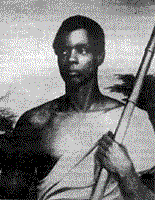 Sierra Leone and the United States.
Sierra Leone and the United States.
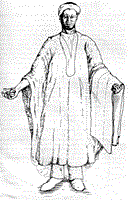
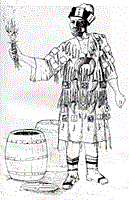
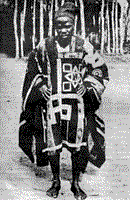 the famous Mende warrior, Ndawa, in a
series of military campaigns against Chief Benya of Small Bo but Kail
Londo fell out with Ndawa over the treatment of his men and the division
of spoils. Ndawa took revenge on Kai Londo by leading a large army into
the heart of Luawa country, and the Kissi elders met and called upon Kai
to lead the men of Luawa and "defend the land". After a series
of preliminary skirmishes designed to test and confuse the enemy, Kai
Londo led his forces in a punishing dawn attack on Ndawa's camp,
defeating the Mende invaders.
the famous Mende warrior, Ndawa, in a
series of military campaigns against Chief Benya of Small Bo but Kail
Londo fell out with Ndawa over the treatment of his men and the division
of spoils. Ndawa took revenge on Kai Londo by leading a large army into
the heart of Luawa country, and the Kissi elders met and called upon Kai
to lead the men of Luawa and "defend the land". After a series
of preliminary skirmishes designed to test and confuse the enemy, Kai
Londo led his forces in a punishing dawn attack on Ndawa's camp,
defeating the Mende invaders.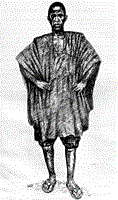 stability to a region that was continually
the target of invasions from both its neighbours and Samori Toure's Sofa
warriors. He was the fifth ruler of Jaiama.
stability to a region that was continually
the target of invasions from both its neighbours and Samori Toure's Sofa
warriors. He was the fifth ruler of Jaiama.